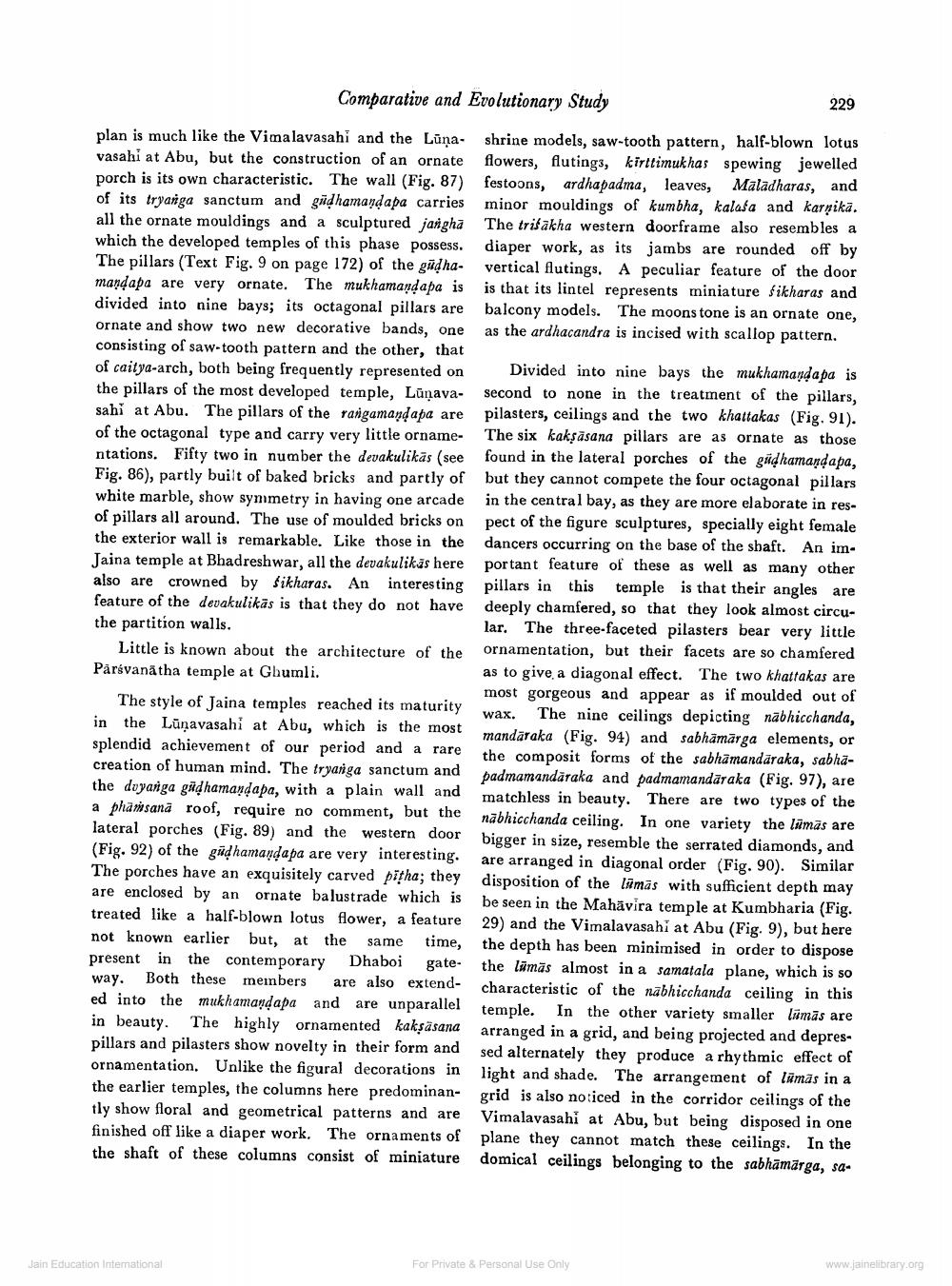________________
Comparative and Evolutionary Study
229
plan is much like the Vimalavasahi and the Lūņa- shrine models, saw-tooth pattern, half-blown lotus vasahi at Abu, but the construction of an ornate flowers, flutings, kirttimukhas spewing jewelled porch is its own characteristic. The wall (Fig. 87) festoons, ardhapadma, leaves, Maladharas, and of its tryanga sanctum and güdhamaydapa carries minor mouldings of kumbha, kalaba and karnika. all the ornate mouldings and a sculptured jangha The trifakha western doorframe also resembles a which the developed temples of this phase possess. diaper work, as its jambs are rounded off by
The pillars (Text Fig. 9 on page 172) of the gūdha- vertical flutings. A peculiar feature of the door mand apa are very ornate. The mukhamandapa is is that its lintel represents miniature Sikharas and divided into nine bays; its octagonal pillars are balcony models. The moonstone is an ornate one, ornate and show two new decorative bands, one as the ardhacandra is incised with scallop pattern. consisting of saw-tooth pattern and the other, that of caitya-arch, both being frequently represented on Divided into nine bays the mukhamandapa is the pillars of the most developed temple, Lūnava. second to none in the treatment of the pillars, sahi at Abu. The pillars of the rangamandapa are pilasters, ceilings and the two khattakas (Fig. 91). of the octagonal type and carry very little orname. The six kaksāsana pillars are as ornate as those ntations. Fifty two in number the devakulikas (see found in the lateral porches of the gudhamandapa, Fig. 86), partly built of baked bricks and partly of but they cannot compete the four octagonal pillars white marble, show symmetry in having one arcade in the central bay, as they are more elaborate in resof pillars all around. The use of moulded bricks on pect of the figure sculptures, specially eight female the exterior wall is remarkable. Like those in the dancers occurring on the base of the shaft. An imJaina temple at Bhadreshwar, all the devakulikās here portant feature of these as well as many other also are crowned by Sikharas. An interesting pillars in this temple is that their angles are feature of the devakulikās is that they do not have deeply chamfered, so that they look almost circuthe partition walls.
lar. The three-faceted pilasters bear very little Little is known about the architecture of the ornamentation, but their facets are so chamfered Pārsvanatha temple at Ghumli.
as to give a diagonal effect. The two khattakas are
most gorgeous and appear as if moulded out of The style of Jaina temples reached its maturity
wax. The nine ceilings depicting nabhicchanda, in the Lūņavasahi at Abu, which is the most
mandāraka (Fig. 94) and sabhämärga elements, or splendid achievement of our period and a rare
the composit forms of the sabhāmandāraka, sabhacreation of human mind. The tryaniga sanctum and badmamandāraka and padmamandāraka (Fig. 97), are the doyanga gädhamandapa, with a plain wall and
matchless in beauty. There are two types of the a phasana roof, require no comment, but the nābhicchanda ceiling. In one variety the lamās are lateral porches (Fig. 89) and the western door bigger in size, resemble the serrated diamonds, and (Fig. 92) of the güdhamanda pa are very interesting. are arranged in diagonal order (Fig. 90). Similar The porches have an exquisitely carved pitha; they disposition of the limãs with sufficient depth may are enclosed by an ornate balustrade which is be seen in the Mahavira temple at Kumbharia (Fig. treated like a half-blown lotus flower, a feature 29) and the Vimalavasahi at Abu (Fig. 9), but here not known earlier but, at the same time, the depth has been minimised in order to dispose present in the contemporary Dhaboi gate. the lümās almost in a samatala plane, which is so way. Both these members are also extend- characteristic of the nabhicchanda ceiling in this ed into the mukhamaņdapa and are unparallel temple. In the other variety smaller limās are in beauty. The highly ornamented kaksāsana arranged in a grid, and being projected and deprespillars and pilasters show novelty in their form and sed alternately they produce a rhythmic effect of ornamentation. Unlike the figural decorations in light and shade. The arrangement of limās in a the earlier temples, the columns here predominan- grid is also noticed in the corridor ceilings of the tly show floral and geometrical patterns and are Vimalayasahi at Abu, but being disposed in one finished off like a diaper work. The ornaments of plane they cannot match these ceilings. In the the shaft of these columns consist of miniature domical ceilings belonging to the sabhāmārga, sa
Jain Education International
For Private & Personal Use Only
www.jainelibrary.org




